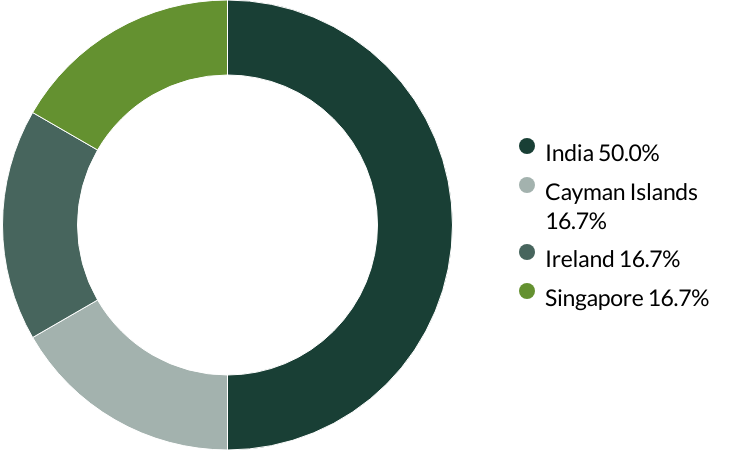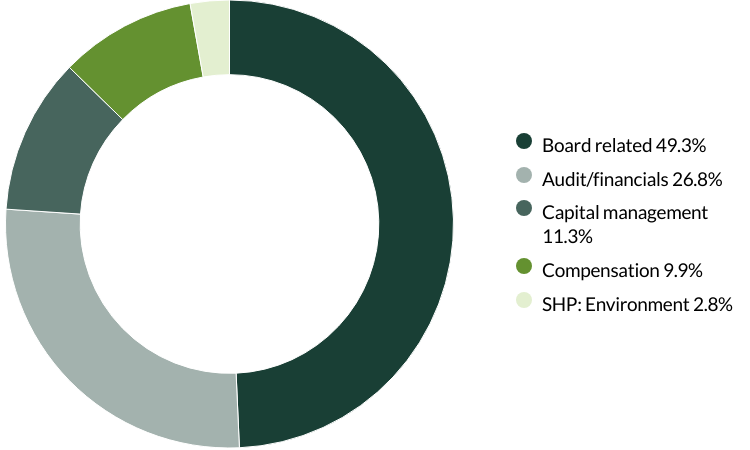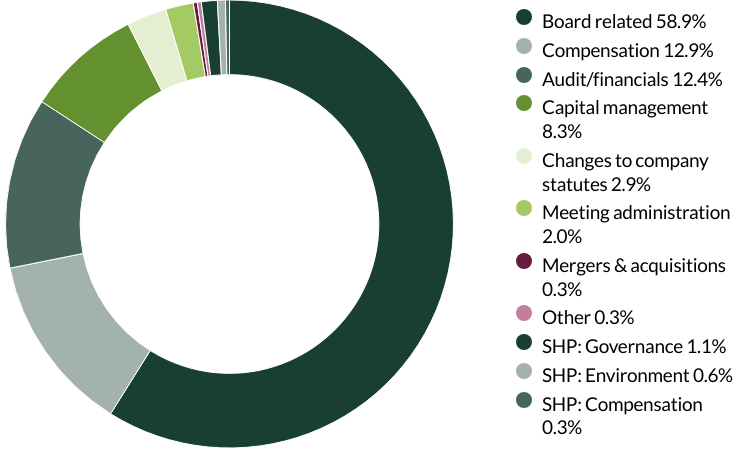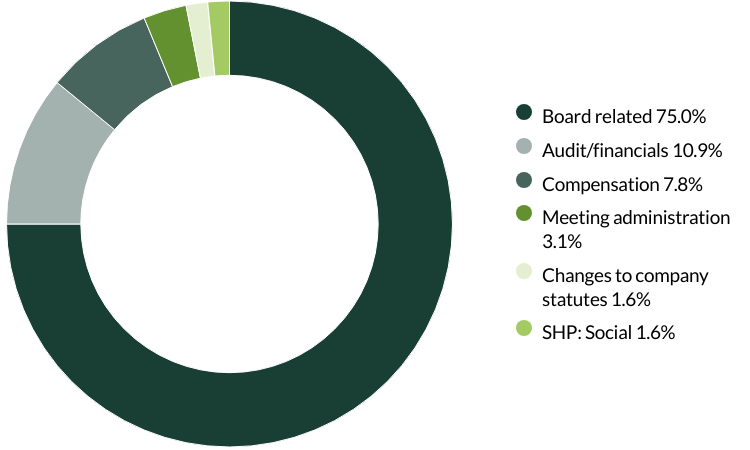Get the right experience for you. Please select your location and investor type.
IMPORTANT NEWS: Transition of investment management responsibilities
First Sentier Group, the global asset management organisation, has announced a strategic transition of Stewart Investors' investment management responsibilities to its affiliate investment team, FSSA Investment Managers, effective Friday, 14 November close of business EST.

Worldwide Leaders
The Worldwide Leaders Sustainability strategy launched in November 2013 and transitioned to become a dedicated sustainability strategy in October 2016.
Strategy overviewThe Worldwide Leaders strategy launched in November 2013 and transitioned to become a dedicated sustainability strategy in October 2016. The strategy invests in 30-60 high-quality global companies that are particularly well positioned to contribute to, and benefit from, sustainable development.
Leaders simply means that this strategy is focused on companies with a market cap value of at least USD5 billion.
Strategy highlights: a focus on quality and sustainability
- We invest in high-quality companies with exceptional cultures, strong franchises and resilient financials. How we pick companies >
- Our approach is long-term, bottom-up, high conviction and benchmark agnostic
- We focus on capital preservation as well as capital growth – we define risk as the permanent loss of client capital
- Companies must contribute to sustainable development. Portfolio Explorer >
- We avoid companies linked to harmful activities and engage and vote for positive change. Our position on harmful products >
Latest insights
Quarterly update
Strategy update: Q3 2025
Worldwide Leaders strategy update: 1 July - 30 September 2025
On one level, the third quarter saw significant changes at Stewart Investors. After acting as careful stewards of our clients’ capital over many years, three of our colleagues stepped back from their portfolio-management responsibilities in August and left the business.
As part of those changes, Nick Edgerton has been appointed as the new lead manager of the Worldwide Leaders strategy. As the existing lead portfolio manager of our Worldwide All Cap strategy, Nick has been involved in analysing companies and discussing the construction of Stewart Investors’ worldwide strategies since he joined the investment team in 2012. He will continue to apply the same principles to managing this strategy that have guided it since its launch, working as part of the same tight-knit group of investment analysts and drawing on the same common pool of investment ideas.
While the list of portfolio-management responsibilities within our team looks different now than it did when the quarter began, on a deeper level, nothing has changed: the philosophy and approach that has defined Stewart Investors since 1988 is deeply engrained and continues to define what we do. Our structure is flat. Every member of the investment team is first and foremost an analyst and our collective focus is on identifying high-quality companies, with resilient financials, guided by ambitious stewards. This is the bedrock on which the returns of all our strategies, including Worldwide Leaders, have been built.
As analysts, we have always aspired to be excellent generalists rather than narrowly focused sector or country specialists. We scrutinise, debate and decide upon all of the companies that we invest in as a team. Because our understanding is arrived at collectively, because our turnover is low and because much of the information that informs our decision-making doesn’t change on a quarterly basis, we do not immediately lose our insight into companies when an analyst leaves.
Our clients have understandably been keen to discuss the changes that have taken place within our business. Set against that, however, we have been careful to ensure that the majority of our time through the third quarter remained on the companies we invest in and on the environment in which they operate.

The artificial intelligence boom: are the risks of disappointment growing?
It has been nearly three years since ChatGPT astonished the world and triggered a wave of investment in the infrastructure needed to support the rollout of artificial intelligence (AI) models. During that time, the share prices of those companies that are building much of that infrastructure, so-called ‘hyperscalers’ such as Microsoft, Meta, Alphabet and Amazon, have risen sharply. Companies who provide the components of the data centres required to train and run the AI models have also enjoyed significant gains. Nvidia is the highest profile of these but the past three years have also seen sharp gains for businesses such as TSMC, which manufactures advanced semiconductors, and Arista Networks, which makes networking switches.
One consequence of this investment boom is that movements in stock market indices have come to be dominated by the fortunes of fewer and fewer stocks. Such increases in market concentration have happened before, typically when the excitement surrounding a new technology has sparked an infrastructure boom. A similar thing happened with railways in the nineteenth century and then again with the internet 25 years ago. As investors grow enthused by the promise of a new technology, they become willing to project today’s rapid growth persisting into the far-off future and to pay progressively more for those future earnings. While earnings continue to rise, this makes sense. But as market concentration increases around a single theme (AI in this case), and as companies come to be valued at higher and higher multiples of their future earnings, the risks of disappointment grow.
The long-term beneficiaries of today’s AI investment boom will not necessarily be the hyperscalers
In the current boom, one risk arises from the fact that the real world will eventually begin to impose constraints on the number of data centres that can be built. This was highlighted to us by the management teams of some of the companies we met during our recent trip to Texas, one of the states at the epicentre of the data centre boom.
Another risk arises from the fact that it is unclear who will benefit the most from the investments being made today. In the railway and internet booms, the financial benefits did not accrue to the companies that first built the infrastructure, but rather to those businesses that were subsequently able to use it in ways that weren’t fully appreciated when it was being built. (The profits Netflix and Meta are making today arguably rest on the lossmaking investments telecoms companies made in laying fibre optic cables during the last technology boom). At this point, no large revenue streams from the end users of the current generation of AI tools have been identified. The hyperscalers are making the bulk of the investments in physical plant – but we are conscious that they built their dominant positions in a world of low interest rates and flourishing advertising revenues.
As market indices narrow, we invest in a diverse range of companies that are benefitting from a broad range of long-term tailwinds.
How should long-term, fundamental investors approach the risks, opportunities, and uncertainties being presented by the AI boom? Because our definition of ‘risk’ is the permanent loss of our clients’ capital rather than diverging from a benchmark index, we are prepared to relinquish some potential gains in exchange for reducing the risk of loss. And although we certainly own some companies that are benefitting from the current wave of investment in AI and data centres, our investment philosophy is based on the premise that the best way to deliver long-term returns is to hold a diversified portfolio of companies. The companies we invest in address a range of unmet needs and we believe they will grow their cashflows and earnings over a decade or more by meeting those needs. We established two new positions during the quarter, both of which we believe meet that definition.
New holding: Singtel (Singapore: Communication Services)
We bought Singtel in recognition of its resilient cashflows and its attractive valuation. It owns shares in various telecoms businesses across the Asia Pacific region. Totting up the market value of those shareholdings gives a total implied valuation that is higher than Singtel’s current market value. That implies that its two core businesses, SingTel and Optus, an Australian telecoms network, have no value, despite having 4.6 million and 10.5 million subscribers respectively. That mispricing, combined with its refocused leadership under Kuan Moon Yeon and the company’s ability to deliver steady, predictable and diversified cashflows suggests it could be a good investment.
New holding: W.W. Grainger (United States: Industrials).
Grainger is a leading distributor of maintenance, repair, and operations (MRO) products. It serves a diverse range of sectors including manufacturing, government, and healthcare. The breadth of its product range, its excellent logistics and the strength of its relationships should enable it to continue to grow at the expense of its smaller competitors. To fund this addition, we sold the holding in MonotaRO (Japan: Industrials). MonotaRO is in a similar business to Grainger, by whom it is partly owned. By owning shares in the parent company, the strategy gains exposure to growth in the US as well as Japan, thereby diversifying its exposure.
Elsewhere, we topped up our existing position in cybersecurity specialist Fortinet (United States: Information Technology). Its share price fell in August when it signalled that the current upgrade cycle for firewalls was more advanced than investors had realised, implying that future sales of these upgraded components could be smaller than expected. The company subsequently increased the size of its share buyback programme, indicating that it thinks the weakness in its share price represents a great buying opportunity.
We also added to Synopsys (United States: Information Technology) after its share price reacted strongly when it failed to meet earnings expectations. Despite some short-term challenges, it continues to generate healthy cashflows, and the long-term drivers of its growth remain in place.
To help fund these additions, we sold the holdings in Beiersdorf (Germany: Consumer Staples) and Hoya (Japan: Health Care), whose valuations looked less attractive.
Outlook: delivering absolute returns in a relative world
Fear of missing out – ‘FOMO’ – is not confined to the young; it is a natural human instinct. We are conscious that our style of investing, which is designed to deliver compelling absolute returns over the long term (a decade or longer) and to minimise capital losses, has not kept pace with returns from global indices over the short term. We don’t believe that means our philosophy of investing in high-quality companies for extended periods of time has suddenly ceased to work. At a time of change in markets, trade and geopolitics, our underlying approach remains consistent: we continue to focus on generating attractive returns over the long term rather than attempting to outperform through every short-term period. We look forward to demonstrating the fruits of that approach over the years and decades to come.
Case Study: Arista Networks
Listing: New York Stock Exchange
Market cap: USD183 billion1
Held since: 2020
Company description
Arista Networks’ software and hardware connects networks, data centres and cloud-computing nodes.
Investment rationale
Arista was founded in 2004 by three engineers who recognised that the market for networking switches was dominated by sleepy incumbents churning out predictable products with minimal upgrades. They set out to disrupt this industry by creating high-performance, low-latency ethernet switches specifically designed for cloud computing and data centres. Having experienced firsthand how Cisco Systems operated, they knew that they could create a company that did things differently in its focus on innovation, in its operating model, and in its culture.
At the time of its launch in 2010, the company’s first product had five times the throughput of its closest competitor.2 It then enhanced its lead by pursuing a programme of innovation and improvement, made possible by investing heavily in research and development.
Two early decisions taken by the company’s founders provided a platform for its subsequent growth. The first was to integrate a proprietary operating system, Arista EOS, into its hardware. This allows its customers to see what is happening across their networks in a single image and to fix issues seamlessly and with minimal network downtime. Arista built that software using open-source (Linux) code, allowing new best-of-breed software to be incorporated as it becomes available.
Their second key decision was to use microchips made by third parties rather than developing their own. By using off-the-shelf components and outsourcing manufacturing to local fulfilment centres, Arista can keep costs down, bring new innovations to market quickly, and benefit from industry-wide improvements in chip size, power usage and computing capacity.
Although two of the company’s three founders remain involved today, they made an early decision to hire a chief executive to run it. Jayshree Ullal joined in 2008, two years before Arista’s first product launch and six years before its IPO (initial public offering). She has been the key to establishing and nurturing its culture of customer focus, innovation, frugality, and flat hierarchies. This combination of a longstanding chief executive supported by the company’s founders has created an ownership mentality that has cascaded through the workforce, helped by its flat structure and lean workforce. Employees are accountable and empowered to openly address and fix problems.
One part of that culture is a refusal to sacrifice quality for speed; Arista will not ship a new product until its engineers are happy that it will operate as expected. This maintains its reputation for reliability, helps it to win repeat business, and supports its long-term partnerships with its two largest customers, Microsoft and Meta, who together account for approximately a third of its revenues.3 And although that means it faces a degree of concentration risk, it also makes it a direct beneficiary of the investments these companies are making in building artificial intelligence (AI) data centres.
Arista is taking steps to mitigate that concentration risk by diversifying its customer base within the US, which currently accounts for approximately three quarters of its revenues, as well as by expanding overseas.4 For example, it recently launched a ‘Make in India’ initiative, through which it is investing in local manufacturing, developing skills, and building centres of excellence in ‘AI for networking’ across the country.
Arista’s strong cash-flow generation, its high profit margins and low debts give it the financial firepower to continue investing in research and development while also acquiring companies to benefit from their technology and engineering expertise. This continual reinvestment in innovation should help it to stay ahead of the pack while exploiting the significant areas of potential growth in front of it.
What could go wrong? / Risks
The clearest risk is posed by customer concentration; any difficulties in Arista’s relationships with either Microsoft or Meta could lead to a fall in its revenues and potential reputational issues. Ongoing price deflation, meanwhile, means that it must innovate continually – and run harder – to increase sales and profits. Finally, there is always the risk that an acquisition goes badly, affecting the company’s culture and causing it to lose its leadership in innovation.
[1] Source: FactSet as at 1 October 2025.
[2] Source: Arista: Arista 7500 - Sets New Standard for 10 Gigabit Ethernet Networking https://www.arista.com/en/company/news/press-release/280-pr-20100419-01.
[3] Source: Arista Networks 10-Q 6 August 2025.
[4] Source: FactSet as of 1 October 2025.
Source for company information: Stewart Investors investment team and company data. This stock information does not constitute any offer or inducement to enter into any investment activity. Portfolio data shown is from representative strategy accounts of the strategy shown above. Named new investments disclosed relate to holdings with a portfolio weight over 0.5%. It is not a recommendation or solicitation to purchase or invest in any fund. Differences between the representative account-specific constraints, currency or fees and those of a similarly managed fund or mandate would affect results.
Voting
Voting: Q3 2025
Worldwide Leaders voting: 1 July - 30 September 2025
Voting by country of origin
Voting by proposal category
During the quarter there were 74 proposals from five companies to vote on. On behalf of our clients, we did not vote against any proposals.
We supported of a shareholder proposal at Linde, which requested transparency on how the company’s lobbying activity aligns with its climate goals. (one proposal)
Source for company information: Stewart Investors investment team and company data. This stock information does not constitute any offer or inducement to enter into any investment activity. Portfolio data shown is from representative strategy accounts of the strategy shown above. Voting chart numbers may not add to 100 due to rounding. SHP means: Shareholder Proposal.
Voting: Q2 2025
Worldwide Leaders voting: 1 April - 30 June 2025
Voting by country of origin
Voting by proposal category
During the quarter there were 348 proposals from 27 companies to vote on. On behalf of our clients, we voted against 14 proposals and abstained from voting on six proposals.
We voted against the appointment of the auditor at Arista Networks, Brown & Brown, Expeditors, Fortinet, Lincoln Electric, Markel, NVR, Old Dominion Freight Line, Roper Technologies, Texas Instruments and Westinghouse Air Brake Technologies Corporation (Wabtec) as they have been in place for over 10 years. These companies have given no information on rotating their auditors, something we believe is important to ensure a fresh perspective is brought to their accounts. (11 proposals)
We voted against the recasting of votes (the ability for voters to change their original votes on a particular matter in response to new information or changes to a proposal) for the supervisory council at WEG as we believe the principle of recasting votes for an amended group of candidates is poor practice and would prefer the group to be resubmitted for voting. We also abstained from voting on a request for a separate board election and the election of a supervisory council position. According to Brazilian voting practices, we are unable to vote for this proposal while simultaneously supporting the board in its candidate elections. (two proposals)
We abstained from voting on proposals at Rentokil Initial that would grant the company the authority to issue shares as it did not disclose the reasons for the issuance. Without clearer information regarding the potential capacity expansion and/or acquisition for which this issuance is intended, it is difficult for investors to assess the potential value creation and strategic fit of such an investment. (three proposals)
We abstained from voting on amendments to articles (rules and regulations that govern the company's operations) at bioMérieux as the company did not provide enough information on the amendments. (one proposal)
We abstained from voting on a shareholder proposal at Old Dominion Freight Line regarding the adoption of greenhouse gas (GHG) emissions targets aligned with the Paris Agreement. We were scheduled to meet the company shortly after the annual general meeting (AGM) and prefer to continue discussing this topic directly with the company. (one proposal)
We voted against a shareholder proposal requesting that an independent director serve as chair of the board at Fortinet. We continue to support the current CEO and chair of the board. (one proposal)
We voted against a shareholder proposal regarding simple majority voting at Markel as we support the stewards of the company. (one proposal)
We supported a shareholder proposal regarding greenhouse gas (GHG) emissions disclosure at Markel to encourage improved transparency and better disclosure of relevant emissions data. (one proposal)
We supported shareholder proposals regarding the right to call a special meeting at both NVR and Texas Instruments as we believe that the stock ownership threshold of 10% to call a meeting is appropriate, given the companies’ size and shareholder base. (two proposals)
We supported a shareholder proposal at Synopsys regarding the approval for severance payments (an amount paid to an employee on the early termination of a contract) when they exceed the stated threshold. This support is due to concerns about potential shareholder dilution that larger severance policies might cause. (one proposal)
Source for company information: Stewart Investors investment team and company data. This stock information does not constitute any offer or inducement to enter into any investment activity. Portfolio data shown is from representative strategy accounts of the strategy shown above. Voting chart numbers may not add to 100 due to rounding. SHP means: Shareholder Proposal.
Voting: Q1 2025
Worldwide Leaders proxy voting: 1 January - 31 March 2025
Proxy voting by country of origin
Proxy voting by proposal category
During the quarter there were 64 resolutions from five companies to vote on. On behalf of clients, we voted against six resolutions.
We voted against a proposal on transaction of business at ABB, as they did not provide enough information about the proposal. We wanted to avoid giving them unrestricted decision-making power without sufficient clarity. (one resolution)
We voted against the appointment of the auditor at Costco as they have been in place for over 10 years. The company has given no information on intended rotation, which we believe is important to provide a fresh perspective on the accounts. We voted against a shareholder proposal requesting the company publish a report assessing the risks of maintaining its current diversity, equity and inclusion (DEI) roles, policies and goals as we support the company in their commitment to obey with the law and that their DEI efforts are legally appropriate. (two resolutions)
We voted against the election of two directors and an audit committee member at Samsung Electronics as we do not believe them to be truly independent. (three resolutions)
Source for company information: Stewart Investors investment team and company data. This stock information does not constitute any offer or inducement to enter into any investment activity. Portfolio data shown is from representative strategy accounts of the strategy shown above. Voting chart numbers may not add to 100 due to rounding. SHP means: Shareholder Proposal.
Voting: Q4 2024
Worldwide Leaders proxy voting: 1 October - 31 December 2024
Proxy voting by country of origin
Proxy voting by proposal category
During the quarter there were 25 resolutions from two companies to vote on. On behalf of clients, we voted against one resolution.
We voted against the re-appointment of the auditor at Copart as they have been in place for or over 10 years and the company has given no information on intended rotation which we believe is important for ensuring a fresh perspective on the accounts. (one resolution)
Source for company information: Stewart Investors investment team and company data. This stock information does not constitute any offer or inducement to enter into any investment activity. Portfolio data shown is from representative strategy accounts of the strategy shown above. Voting chart numbers may not add to 100 due to rounding. SHP means: Shareholder Proposal.
Portfolio Explorer
If you are unable to view the portfolio explorer, please re-open in Google Chrome, Edge, Firefox, Safari or Opera. IE11 is not supported.
For illustrative purposes only. Reference to the names of example company names mentioned in this communication is merely for explaining the investment strategy and should not be construed as investment advice or investment recommendation of those companies. Companies mentioned herein may or may not form part of the holdings of Stewart Investors. Holdings are subject to change.
Certain statements, estimates, and projections in this document may be forward-looking statements. These forward-looking statements are based upon Stewart Investors’ current assumptions and beliefs, in light of currently available information, but involve known and unknown risks and uncertainties. Actual actions or results may differ materially from those discussed. Readers are cautioned not to place undue reliance on these forward-looking statements. There is no certainty that current conditions will last, and Stewart Investors undertakes no obligation to correct, revise or update information herein, whether as a result of new information, future events or otherwise.
Source: Stewart Investors investment team and company data. Securities mentioned are all investee companies* from representative Asia Pacific All Cap Strategy, Asia Pacific & Japan All Cap Strategy, Asia Pacific Leaders Strategy, Global Emerging Markets (ex China) Leaders Strategy, Global Emerging Markets Leaders Strategy, Global Emerging Markets All Cap Strategy, Indian Subcontinent All Cap Strategy, Worldwide All Cap Strategy and Worldwide Leaders Strategy accounts as at 30 September 2025. *Assets that the strategies may hold which an active decision has not been made, and sustainability assessment does not apply, include cash, cash equivalents, short-term holdings for the purpose of efficient portfolio management and holdings received as a result of mandatory corporate actions. Holdings of such assets will not appear on Portfolio Explorer. Not all strategies are available in all jurisdictions or to all audience types.
The Stewart Investors supports the Sustainable Development Goals (SDGs). The full list of SDGs can be found on the United Nations website.
Source for Climate Solutions and impact figures: © 2014–2025 Project Drawdown (drawdown.org). Source for Human Development Pillars: Stewart Investors investment team.
Source for climate solutions and human development analysis and mapping: Stewart Investors investment team. Contributions are defined by the team as demonstrable contributions to any solution, either direct (directly attributable to products, services or practices provided by that company), or enabling (supported or made possible by products or technologies provided by that company).
Investment terms
View our list of investment terms to help you understand the terminology within this website.











